Wave (Current)-Induced Pore Pressure in Offshore Deposits: A Coupled Finite Element Model
Abstract
:1. Introduction
2. Theory and Methods
2.1. Wave Module
2.2. Seabed Module
2.2.1. Oscillatory Response of Soil
2.2.2. Residual Response of Soil
2.3. Coupling Method
2.3.1. Time Scheme
2.3.2. Mesh Scheme
2.3.3. Boundary Conditions
2.3.4. Coupled Process
3. Model Validation
3.1. Wave Verification: Comparison with an Analytical Solution
3.2. Seabed Verification: Comparison with Experimental Data
3.2.1. Validation of the Oscillatory Pore Pressure
3.2.2. Validation of the Residual Pore Pressure
3.3. Wave-Seabed Interaction Verification
4. Model Application
5. Conclusions
Author Contributions
Acknowledgments
Conflicts of Interest
Nomenclature
| Symbol | Description | Units |
| ui | Fluid velocity | [m/s] |
| xi | Coordinate | [m] |
| t | Time | [s] |
| Fluid density | [kg/m3] | |
| p | Fluid pressure | [N/m2] |
| gi | Gravitational force | [m/s2] |
| Viscous stress tensor | [N/m2] | |
| Source Region | [-] | |
| Si | Momentum source function | [m/s2] |
| Angular frequency | [/s] | |
| k | Wave number | [/m] |
| Wave obliquity | [1] | |
| Wave amplitude | [m] | |
| L | Wavelength | [m] |
| C | Wave velocity | [m/s] |
| Free surface elevation | [m] | |
| pe | Wave-induce pore pressure | [Pa] |
| Oscillatory pore pressure | [Pa] | |
| Residual pore pressure | [Pa] | |
| Unite weight of water | [N/m3] | |
| ns | Soil Porosity | [1] |
| Volume strain | [1] | |
| Compressibility of pore fluid | [/Pa] | |
| us, ws | Soil displacements | [m] |
| Kw | True elasticity modulus of pore water | [Pa] |
| Pw0 | Absolute water pressure | [Pa] |
| S | Seabed degree of saturation | [1] |
| Total stress | [Pa] | |
| Effective stress | [Pa] | |
| Kronecker delta | [1] | |
| G | Shear modulus | [Pa] |
| Poisson’s ratio | [1] | |
| Kv | Bulk modulus of soil | [Pa] |
| Plastic volumetric strain | [1] | |
| R | Material parameters | [1] |
| Cyclic stress ratio | [1] | |
| Maximum amplitude of shear stress | [Pa] | |
| Initial effective stress in vertical direction | [Pa] | |
| Wave pressure on seabed surface | [Pa] | |
| Shear stress at the seabed surface | [Pa] | |
| h | Seabed thickness | [m] |
| Turbulent dissipation rate | [1] | |
| Kinetic viscosity | [kg/m/s] | |
| Eddy viscosity | [kg/m/s] |
References
- Damgaard, J.S.; Sumer, B.M.; Teh, T.C.; Palmer, A.C.; Foray, P.; Osorio, D. Guidelines for Pipeline On-Bottom Stability on Liquefied Noncohesive Seabeds. J. Waterw. Port Coast. Ocean Eng. 2006, 132, 300–309. [Google Scholar] [CrossRef]
- De Groot, M.B.; Kudella, M.; Meijers, P.; Oumeraci, H. Liquefaction Phenomena underneath Marine Gravity Structures Subjected to Wave Loads. J. Waterw. Port Coast. Ocean Eng. 2006, 132, 325–335. [Google Scholar] [CrossRef]
- Mutlu, S.B. Liquefaction Around Marine Structures (With Cd-rom); World Scientific: Hackensack, NJ, USA, 2014; ISBN 9814603732. [Google Scholar]
- Maljaars, P.; Bronswijk, L.; Windt, J.; Grasso, N.; Kaminski, M. Experimental Validation of Fluid–Structure Interaction Computations of Flexible Composite Propellers in Open Water Conditions Using BEM-FEM and RANS-FEM Methods. J. Mar. Sci. Eng. 2018, 6, 51. [Google Scholar] [CrossRef]
- Chiang, C.Y.; Pironneau, O.; Sheu, T.; Thiriet, M. Numerical Study of a 3D Eulerian Monolithic Formulation for Incompressible Fluid-Structures Systems. Fluids 2017, 2, 34. [Google Scholar] [CrossRef]
- Devolder, B.; Stratigaki, V.; Troch, P.; Rauwoens, P. CFD Simulations of Floating Point Absorber Wave Energy Converter Arrays Subjected to Regular Waves. Energies 2018, 11, 641. [Google Scholar] [CrossRef]
- Hsu, J.R.C.; Jeng, D.S. Wave-induced soil response in an unsaturated anisotropic seabed of finite thickness. Int. J. Numer. Anal. Methods Geomech. 1994, 18, 785–807. [Google Scholar] [CrossRef]
- Ulker, M.B.C.; Rahman, M.S.; Jeng, D.S. Wave-induced response of seabed: Various formulations and their applicability. Appl. Ocean Res. 2009, 31, 12–24. [Google Scholar] [CrossRef]
- Tong, D.; Liao, C.; Jeng, D.-S.; Zhang, L.; Wang, J.; Chen, L. Three-dimensional modeling of wave-structure-seabed interaction around twin-pile group. Ocean Eng. 2017, 145, 416–429. [Google Scholar] [CrossRef]
- Zhang, Q.; Zhou, X.; Wang, J.; Guo, J. Wave-induced seabed response around an offshore pile foundation platform. Ocean Eng. 2017, 130, 567–582. [Google Scholar] [CrossRef]
- Chen, C.Y.; Hsu, J.R.C. Interaction between internal waves and a permeable seabed. Ocean Eng. 2005, 32, 587–621. [Google Scholar] [CrossRef]
- Jeng, D.S.; Ye, J.H.; Zhang, J.S.; Liu, P.L.F. An integrated model for the wave-induced seabed response around marine structures: Model verifications and applications. Coast. Eng. 2013, 72, 1–19. [Google Scholar] [CrossRef]
- Ye, J.; Jeng, D.; Wang, R.; Zhu, C. Validation of a 2-D semi-coupled numerical model for fluid-structure-seabed interaction. J. Fluids Struct. 2013, 42, 333–357. [Google Scholar] [CrossRef]
- Hur, D.-S.; Kim, C.-H.; Yoon, J.-S. Numerical study on the interaction among a nonlinear wave, composite breakwater and sandy seabed. Coast. Eng. 2010, 57, 917–930. [Google Scholar] [CrossRef]
- Choi, J.; Yoon, S.B. Numerical simulations using momentum source wave-maker applied to RANS equation model. Coast. Eng. 2009, 56, 1043–1060. [Google Scholar] [CrossRef]
- Israeli, M.; Orszag, S.A. Approximation of radiation boundary conditions. J. Comput. Phys. 1981, 41, 115–135. [Google Scholar] [CrossRef]
- Comsol Multiphysics. Comsol Multiphysics User’s Guide; COMSOL Inc.: Burlington, MA, USA, 2010; ISBN 1781273332. [Google Scholar]
- Lin, P.; Liu, P.L.-F. Internal Wave-Maker for Navier-Stokes Equations Models. J. Waterw. Port Coast. Ocean Eng. 1999, 125, 207–215. [Google Scholar] [CrossRef]
- Wei, G.; Kirby, J.T.; Sinha, A. Generation of waves in Boussinesq models using a source function method. Coast. Eng. 1999, 36, 271–299. [Google Scholar] [CrossRef] [Green Version]
- Sassa, S.; Sekiguchi, H. Wave-induced liquefaction of beds of sand in a centrifuge. Geotech. 1999, 49, 621–638. [Google Scholar] [CrossRef]
- Biot, M.A. General theory of three-dimensional consolidation. J. Appl. Phys. 1941, 12, 155–164. [Google Scholar] [CrossRef]
- Yamamoto, T.; Koning, H.L.; Sellmeijer, H.; Hijum, E.V. On the response of a poro-elastic bed to water waves. J. Fluid Mech. 1978, 87, 193–206. [Google Scholar] [CrossRef]
- Liao, C.C.; Zhao, H.; Jeng, D.-S. Poro-Elasto-Plastic Model for the Wave-Induced Liquefaction. J. Offshore Mech. Arct. Eng. 2015, 137, 42001. [Google Scholar] [CrossRef]
- Ye, J.; Jeng, D.S. Effects of bottom shear stresses on the wave-induced dynamic response in a porous seabed: PORO-WSSI (shear) model. Acta Mech. Sin. 2011, 27, 898–910. [Google Scholar] [CrossRef]
- Liu, B.; Jeng, D.S.; Ye, G.L.; Yang, B. Laboratory study for pore pressures in sandy deposit under wave loading. Ocean Eng. 2015, 106, 207–219. [Google Scholar] [CrossRef]
- Sekiguchi, H.; Kita, K.; Okamoto, O. Response of Poro-Elastoplastic Beds to Standing Waves. Soils Found. 1995, 35, 31–42. [Google Scholar] [CrossRef]
- Qi, W.G.; Gao, F.P. Physical modeling of local scour development around a large-diameter monopile in combined waves and current. Coast. Eng. 2014, 83, 72–81. [Google Scholar] [CrossRef]
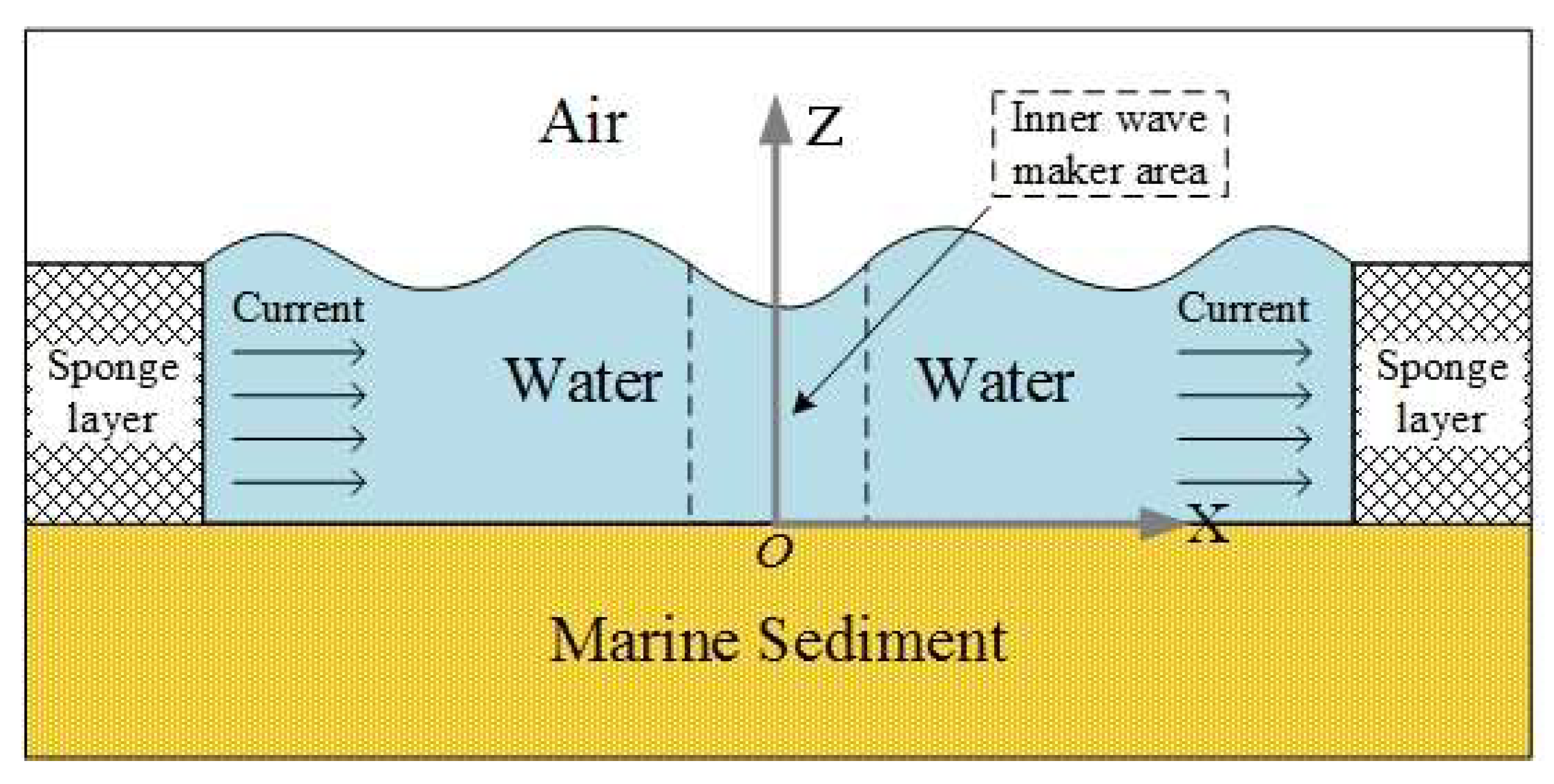
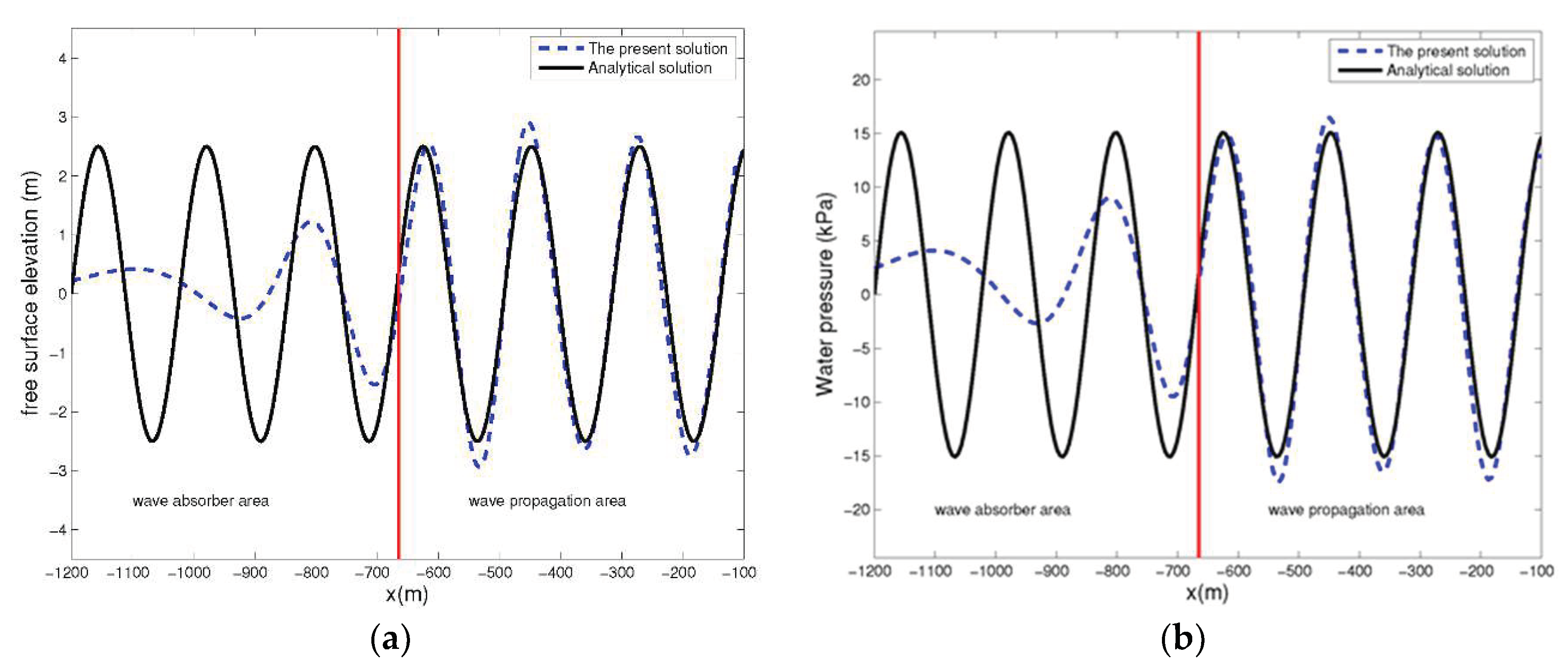
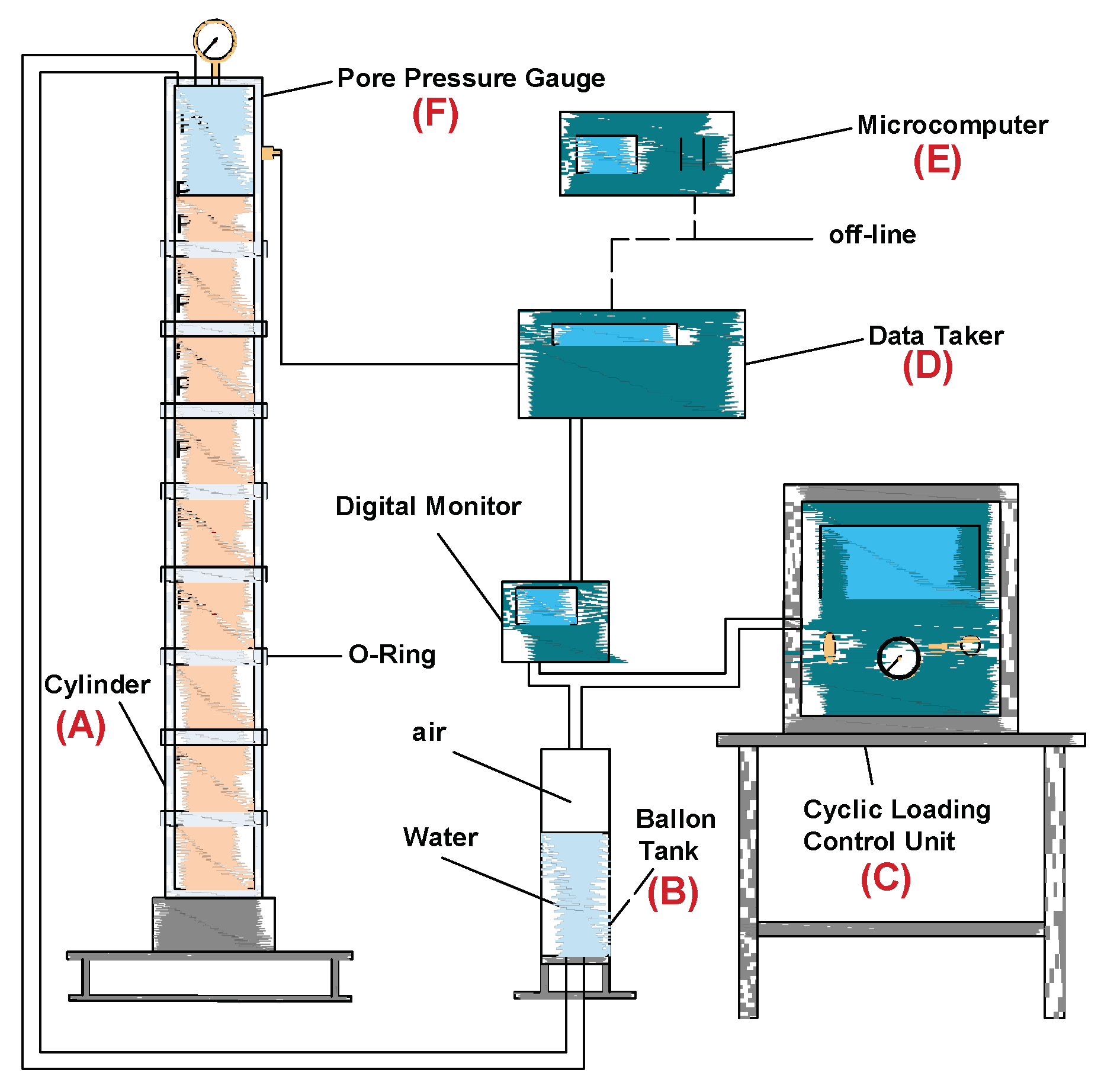
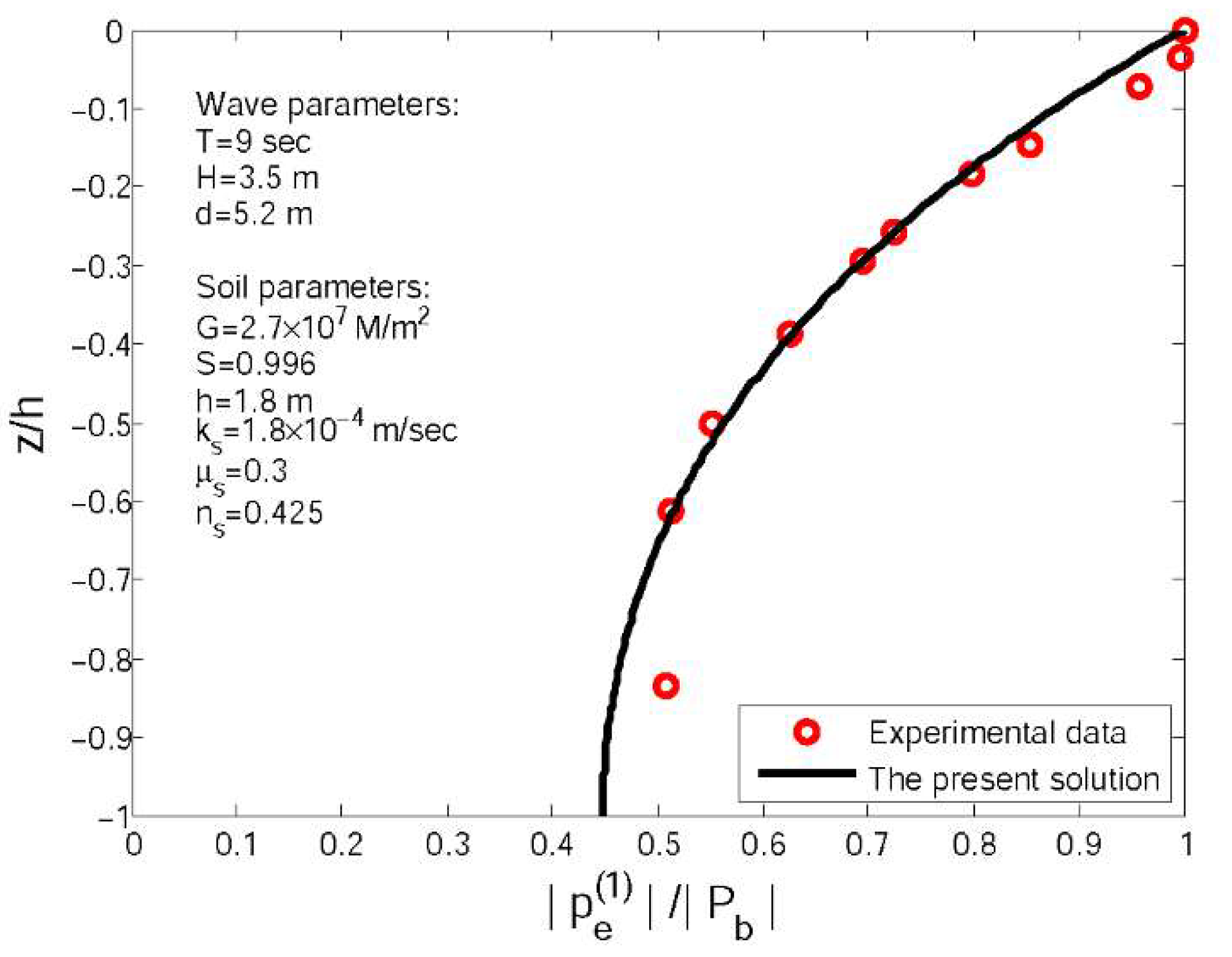
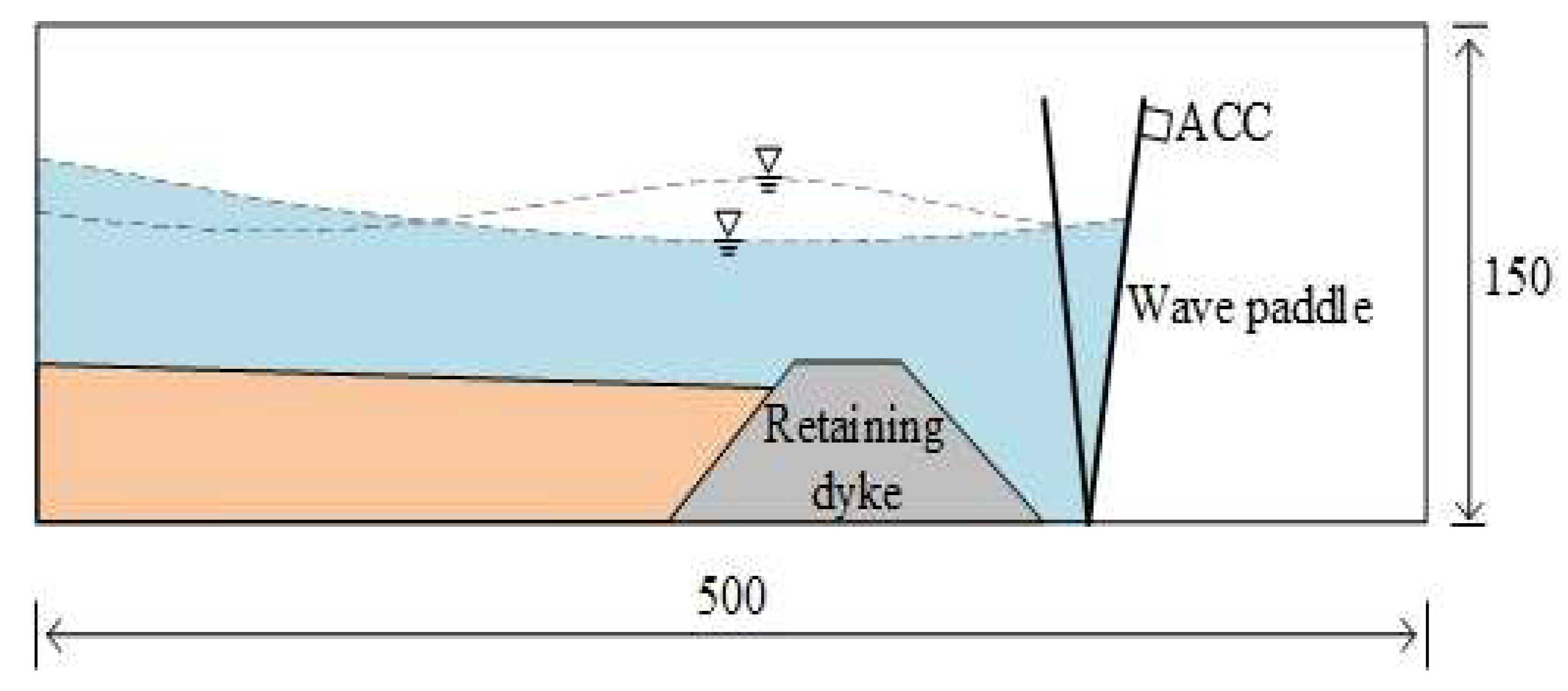
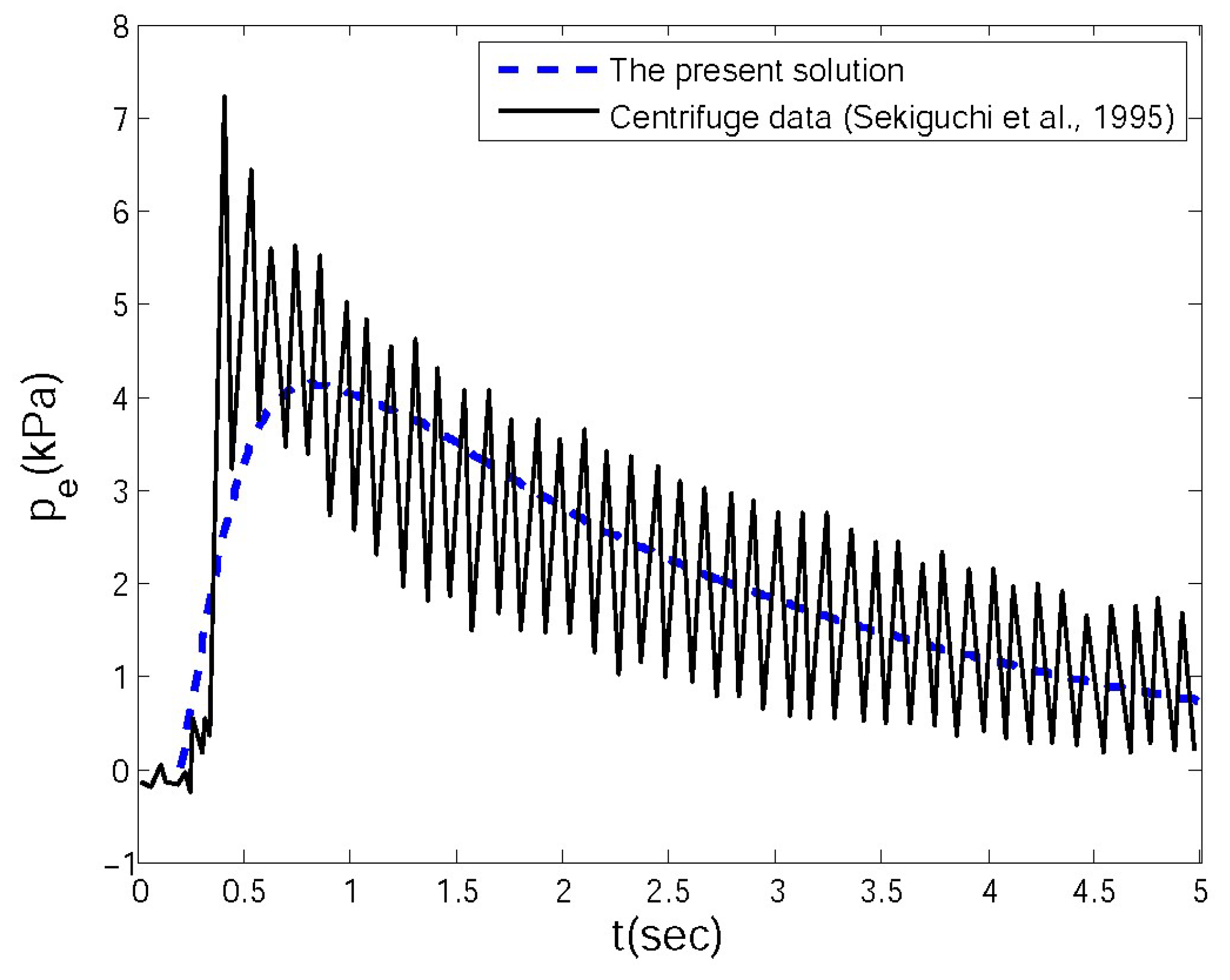
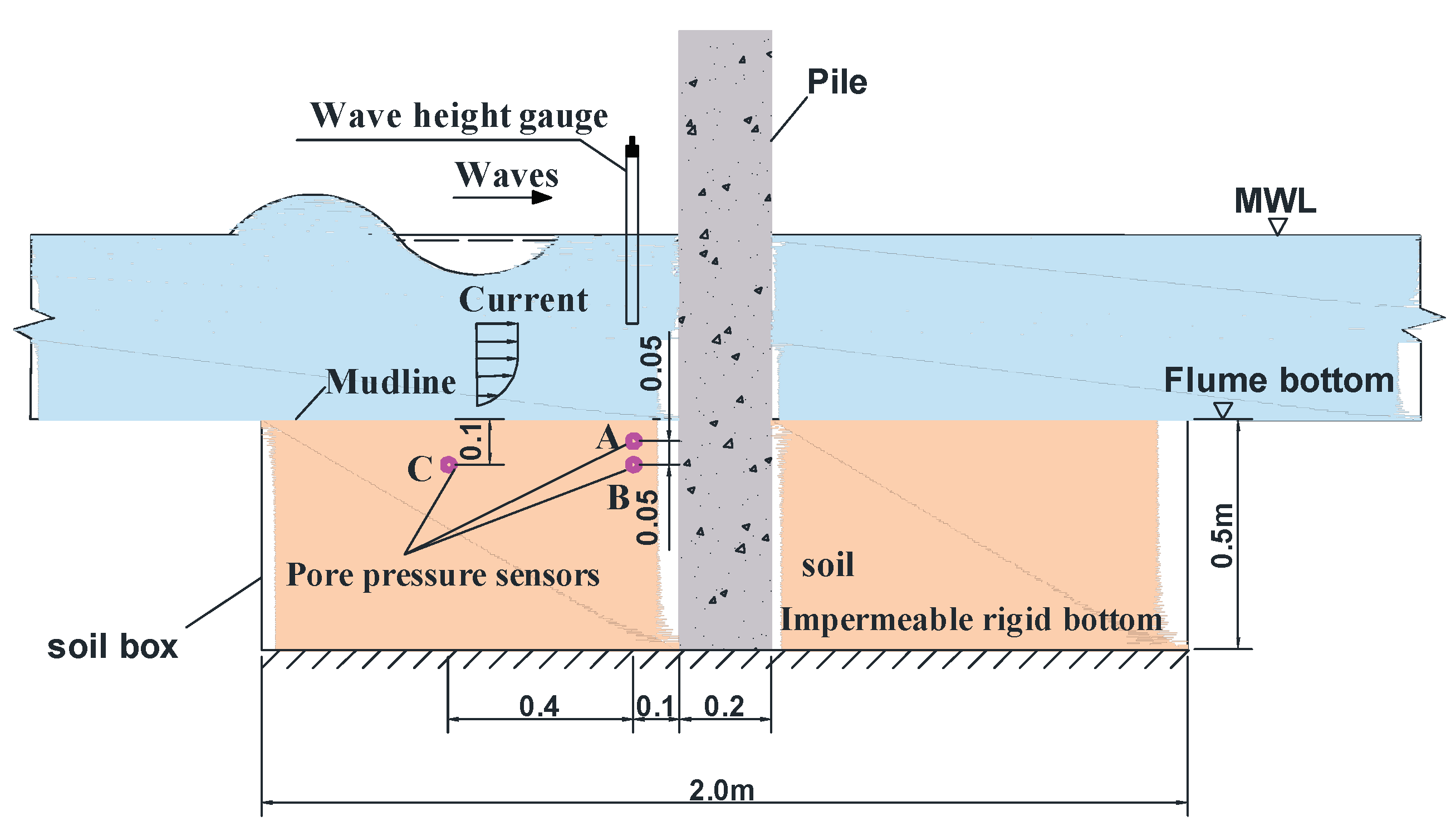
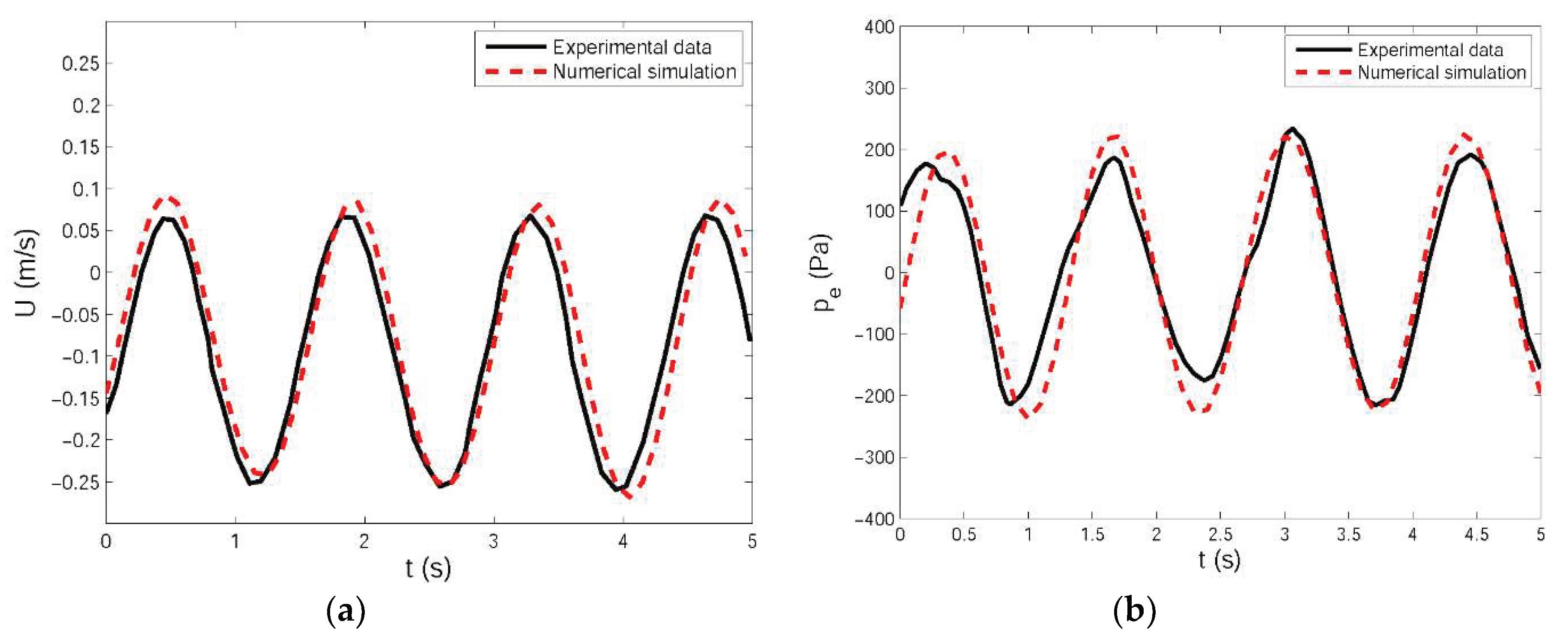

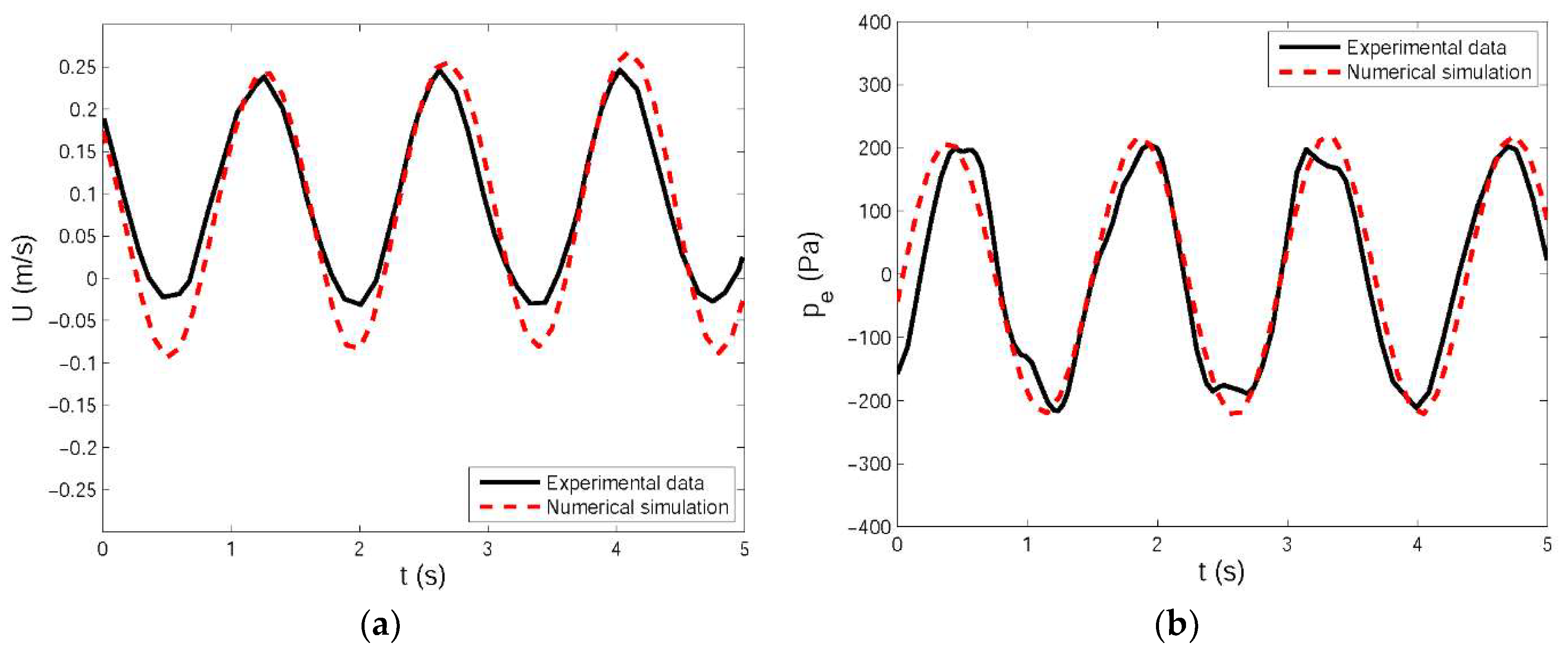
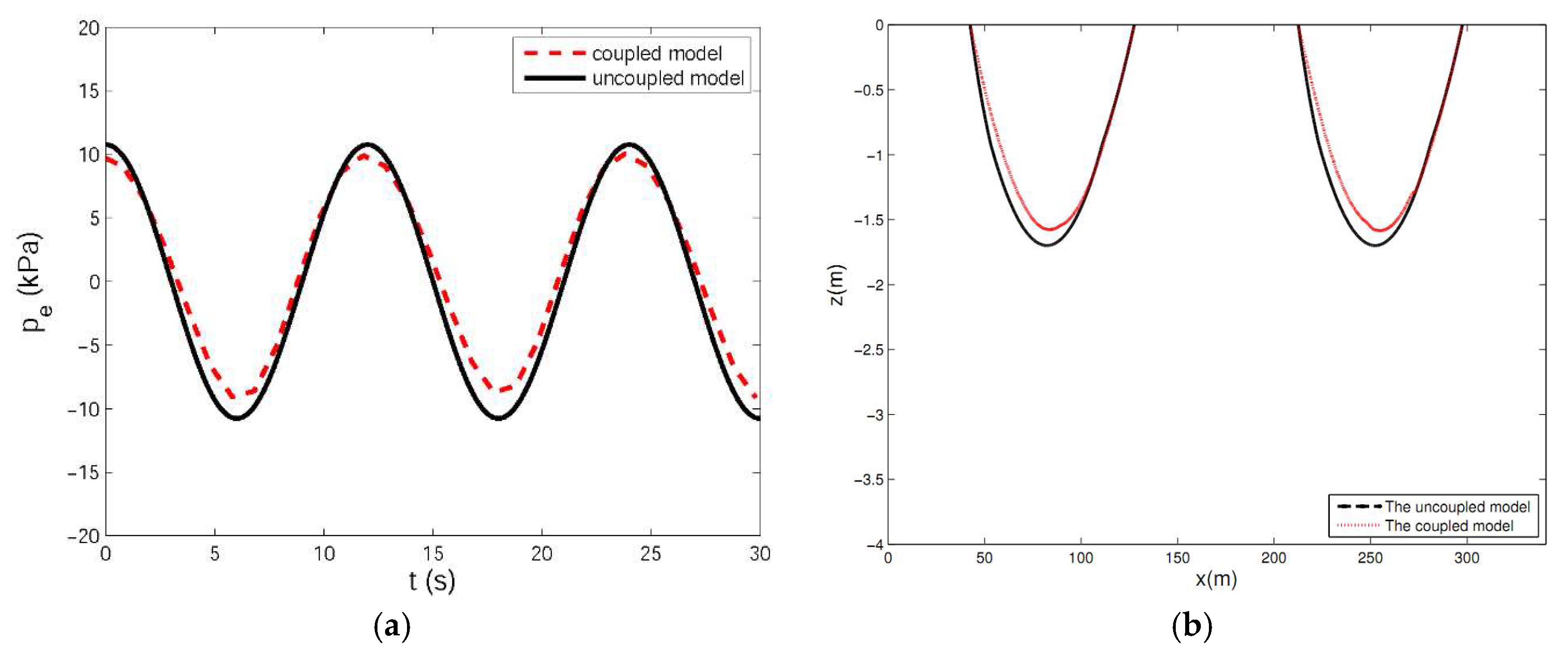
| Wave Characteristics | Value | Soil characteristics | Value |
|---|---|---|---|
| Wave period (T) | 12.0 s | Permeability (K) | 1.0 × 10−4 m/s |
| Porosity (ne) | 0.30 | ||
| Wave length (H) | 170.0 m | Shear modulus (G) | 1.0 × 107 N/m2 |
| Thickness (h) | ∞ m | ||
| Water depth (d) | 30.0 m | Poisson’s ratio (μ) | 0.35 |
| Degree of saturation (S) | 1 | ||
| Wave amplitude (η) | 2.5 m |
© 2018 by the authors. Licensee MDPI, Basel, Switzerland. This article is an open access article distributed under the terms and conditions of the Creative Commons Attribution (CC BY) license (http://creativecommons.org/licenses/by/4.0/).
Share and Cite
Liao, C.; Jeng, D.; Lin, Z.; Guo, Y.; Zhang, Q. Wave (Current)-Induced Pore Pressure in Offshore Deposits: A Coupled Finite Element Model. J. Mar. Sci. Eng. 2018, 6, 83. https://doi.org/10.3390/jmse6030083
Liao C, Jeng D, Lin Z, Guo Y, Zhang Q. Wave (Current)-Induced Pore Pressure in Offshore Deposits: A Coupled Finite Element Model. Journal of Marine Science and Engineering. 2018; 6(3):83. https://doi.org/10.3390/jmse6030083
Chicago/Turabian StyleLiao, Chencong, Dongsheng Jeng, Zaibin Lin, Yakun Guo, and Qi Zhang. 2018. "Wave (Current)-Induced Pore Pressure in Offshore Deposits: A Coupled Finite Element Model" Journal of Marine Science and Engineering 6, no. 3: 83. https://doi.org/10.3390/jmse6030083







